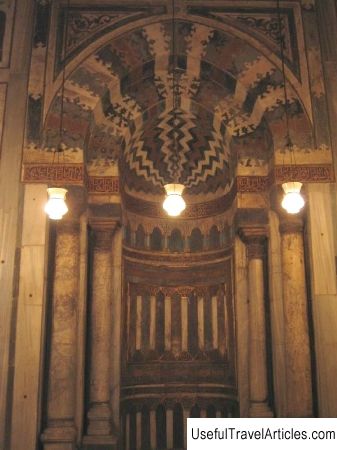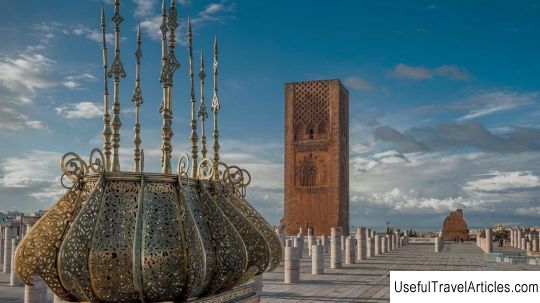Sultan Hassan Mosque description and photos - Egypt: Cairo
Rating: 8,5/10 (2543 votes) 
Sultan Hassan Mosque description and photos - Egypt: Cairo. Detailed information about the attraction. Description, photographs and a map showing the nearest significant objects. The title in English is Sultan Hassan Mosque. Photo and descriptionThe ensemble of the Sultan Hasan's mosque-madrasah is one of the most famous monuments of Mamluk art. The founder of this gigantic monument is the son of the great Mamluk sultan, Al-Nasser Mohamed ibn Kalawoun. Sultan Hassan actually ruled Egypt twice: the first time in 1347, when he was only 13 years old, and his second rule of the country began in 1356 and lasted until 1361. The mosque is located near the Citadel, in the Salah al-Din square. This temple is one of the largest not only in Cairo, but in the entire Islamic world. It is a massive structure about 150 meters long and 36 meters high, the height of the minaret is 68 meters. Work on the construction of the building began in 1356 and lasted for more than five years. The project was funded from various sources, including money from the sale of property of people who died in Cairo from the bubonic plague in 1348. The mosque was erected next to the Citadel, on the site of an old palace. In the Middle Ages, the area between the fortress and the mosque was common and strategic. During the Mamluk uprising, the fortress was shelled from the roof of the mosque, it was especially convenient to do this from the minarets. For this reason, the next ruler, Sultan Dzhanbulat, tried to demolish the mosque, but after three days of unsuccessful attempts he abandoned this venture, broke only the stairs and two minarets, making it impossible to use them in attacks on the fort. The plans provided four minaret, but only three were built. During the work, one of the towers collapsed, burying under itself more than three hundred people, and in 1361 Sultan Hassan would have been killed, his body was not found, but the construction was nevertheless completed. The religious building is notable for its enormous size, its ayvans are one of the largest among such structures. A unique feature of the mosque is the large wooden egg-shaped dome. An exceptional example of Mamluk architecture is the construction of two portal minarets, which does not correspond to the gigantic dimensions of the temple. Each of the facades of the mausoleum is decorated in the center with a medallion with an `` apple '' framed by intertwined two-tone stripes, as well as two rows of windows. The upper ones are inserted into niches, crowned with stalactites with shallow shells for portals. The lower windows are located in recesses of a stepped pyramidal profile with traces of mosaics. The south and north facades also have several rows of windows. Front decoration - lancet bas-reliefs, black basalt, beamed corners of facades with small carved columns with stalactite capitals and twisted decor, which resembles the Byzantine style. The entrance to the mosque is simply huge, located on Al-Kala Shebaa Street. There is a floor plan near the entrance with some historical information in Arabic and English. The portal itself is offset from the center of the facade and is angled to the rest of the wall. The semi-dome above the door is corrugated, stepped, the height of the opening is emphasized by spiral pilasters, as well as vertical panels on the sides of the porch. Right next to the entrance there are two marble niches inlaid with geometric patterns, large stone benches are installed in the vestibule, above them there are medallions and carved stone recesses, the color scheme of the corridor is traditional for the Mamluks - from dark red to brown. In the center of the courtyard there is a large ablution fountain, which was completed in 1362. It is covered with a wooden pommel supported by marble columns. The dome is very high, richly decorated with traditional paintings, mosaics and stones. The base of the dome is decorated with inscriptions from the Koran. The interiors are striking in size and luxury; the complex includes a madrasah, a hospital, a mausoleum and technical premises. The mausoleum is located behind Qibla Ayvan, it was conceived as the tomb of Sultan Hasan, but since Vladyka's body was never found; two of his sons are buried here. The lighting inside is soft, except for the lamps in the center above the sarcophagus, there are many small windows in the walls. The tomb itself is surrounded by a small carved wooden fence, behind is a mihrab,       Topic: Sultan Hassan Mosque description and photos - Egypt: Cairo. |




